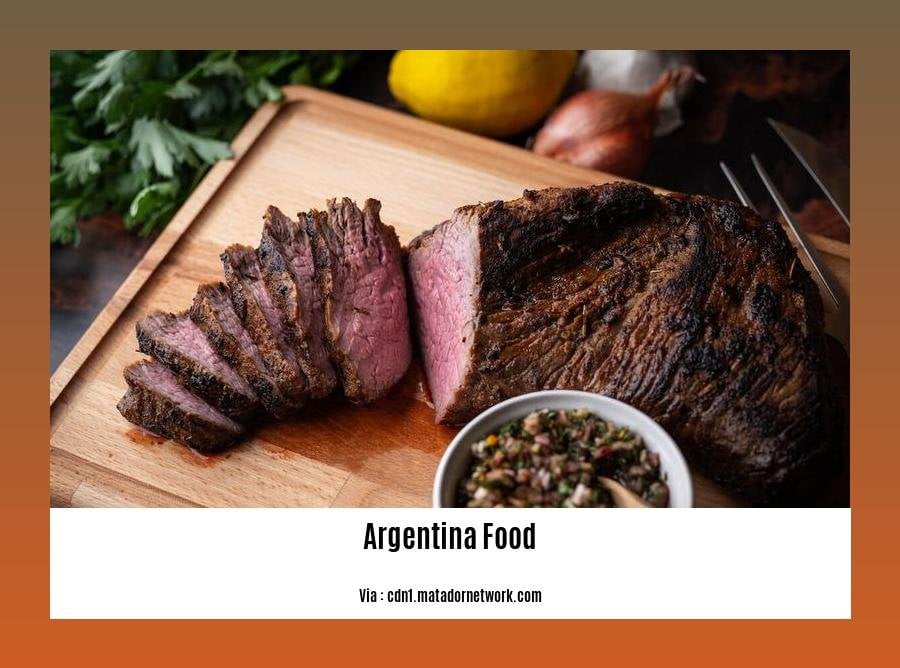Step into the vibrant world of Argentinian cuisine, where flavors dance on the palate and traditions run deep. Embark on a culinary journey through Argentina Food Facts, a treasure trove of insights, stories, and mouthwatering experiences. From the sizzling parrilla grills to the delicate sweetness of alfajores, we’ll explore the ingredients, techniques, and cultural influences that make Argentine food a feast for the senses. So, prepare your taste buds and join us on this tantalizing adventure through Argentina’s culinary treasures.
Key Takeaways:
Argentine cuisine blends various cultures, including Mediterranean (Italian, Spanish), and indigenous influences.
Argentina has the highest per capita consumption of beef in the world.
Traditional Argentinian asado features a variety of beef cuts, sausages, and other meats cooked on a grill.
Potatoes and corn are staples in Argentine cuisine.
Dulce de leche, a sweet caramel sauce, is widely enjoyed in Argentina.
Argentine cuisine shares many popular dishes with other South American countries.
Agriculture flourishes in Argentina, providing a bounty of fresh produce.
Argentine beef is known for its exceptional flavor and tenderness due to the country’s fertile grazing lands.
Asado, the traditional Argentine barbeque, is a social event that brings people together.
Yerba mate, a South American tea brewed from the leaves of the yerba mate plant, is popular in Argentina.
Argentina Food Facts

Argentina is a land of culinary wonders, boasting a unique blend of flavors, traditions, and influences. Discover some intriguing facts about Argentine food:
1. A Carnivore’s Paradise:
- Argentina is renowned for its love for meat, with the highest per capita consumption of beef in the world.
- The traditional Argentinian asado involves grilling various beef cuts, sausages, chicken, and sweetbreads over an open fire.
2. A Taste of Indigenous Heritage:
- Argentinian cuisine reflects the influence of indigenous cultures, incorporating ingredients like corn and potatoes in a variety of dishes.
3. Dulce de Leche: A Sweet Obsession:
- Dulce de leche, a thick, sweet caramel sauce, is a national obsession in Argentina and serves as a popular filling for pastries and desserts.
4. A Melting Pot of Flavors:
- Argentine cuisine is a melting pot of Mediterranean, Spanish, and Italian influences, creating a culinary tapestry of flavors.
5. Fresh Produce: Nature’s Bounty:
- Argentina’s agriculture thrives, providing an abundance of fresh fruits and vegetables that grace local markets and kitchens.
6. Exceptional Beef: A Culinary Gem:
- Argentine beef is celebrated for its exceptional flavor and tenderness, attributed to the country’s fertile grazing lands.
7. Asado: More Than Just a Barbeque:
- Asado, the traditional Argentine barbecue, is not only a meal but a social event, bringing people together to enjoy grilled meats and camaraderie.
8. Yerba Mate: A South American Elixir:
- Yerba mate, a traditional tea brewed from the leaves of the yerba mate plant, is a popular beverage in Argentina, enjoyed for its stimulating and energizing effects.
9. Shared Culinary Heritage:
- Argentine cuisine shares many beloved dishes with other South American countries, reflecting the region’s cultural and culinary connections.
10. A Culinary Journey: Unforgettable Experiences:
- Argentina’s culinary landscape offers unforgettable experiences for food enthusiasts, with its diverse flavors, unique traditions, and vibrant markets, making it a paradise for those seeking a culinary adventure.
Who would have thought that something as seemingly commonplace as alcohol could be shrouded in mystery and intrigue? Discover 5 facts about alcohol that are sure to leave you inebriated with awe!
Many iconic Argentinian dishes, such as empanadas and locro, are believed to have originated with the native indigenous populations. These dishes often incorporate ingredients like corn, potatoes, and squash.
The native indigenous populations of Argentina have left an indelible mark on the country’s culinary landscape. Many iconic dishes that are synonymous with Argentinian cuisine can be traced back to these indigenous roots.
Empanadas:
These ubiquitous pastries are a delightful testament to the fusion of indigenous and Spanish culinary traditions. Filled with savory fillings like minced beef, chicken, or vegetables, these golden pockets of goodness are a popular street food and a staple at gatherings and celebrations.
Locro:
This hearty, comforting stew is a true embodiment of indigenous cuisine. A warming blend of corn, meat, and vegetables, locro is a beloved dish that holds a special place in Argentine hearts. It is traditionally served on May 25th to commemorate the May Revolution.
Ingredients:
The indigenous influence in Argentine cuisine is evident in the frequent use of ingredients like corn, potatoes, and squash. These staples, along with other native produce, form the foundation of many traditional dishes, adding vibrant flavors and textures to the culinary tapestry of Argentina.
Key Takeaways:
- Native indigenous populations made significant contributions to Argentinian cuisine.
- Dishes like empanadas and locro showcase their culinary influence.
- Indigenous ingredients like corn, potatoes, and squash play a vital role in traditional dishes.
Source 1
Source 2
Italian Immigrants’ Profound Impact on Argentine Cuisine

Italian immigrants have had a significant impact on Argentinian cuisine, introducing dishes like pizza and pasta, which have become widely popular. The fusion of Italian and Argentinian culinary traditions has resulted in unique dishes like fugazzeta.
Argentina’s culinary landscape is a vibrant tapestry of flavors, influenced by waves of immigrants who brought their culinary traditions to this South American nation. Among these groups, Italian immigrants have played a pivotal role in shaping the country’s food culture. Their legacy is evident in the popularity of dishes like pizza, pasta, and fugazzeta, a testament to the enduring impact of their culinary heritage.
Pizza:
Who doesn’t love a slice of pizza? In Argentina, pizza is more than just a meal; it’s a passion. Introduced by Italian immigrants in the late 19th century, pizza quickly gained popularity, becoming a staple in homes and restaurants across the country. Today, Argentina boasts a unique style of pizza, with a crispy crust, generous toppings, and a distinctly Argentine flavor.
Pasta:
Pasta, another Italian culinary gift, has become an integral part of Argentine cuisine. From classic spaghetti and meatballs to hearty lasagna, pasta dishes are enjoyed by people of all ages. Argentine pasta often incorporates local ingredients, such as fresh vegetables and flavorful sauces made with local herbs and spices.
Fugazzeta:
Fugazzeta stands as a testament to the fusion of Italian and Argentine culinary traditions. This unique dish combines the beloved flavors of pizza with the rich, savory flavors of Argentine cuisine. Topped with cheese, onions, and sometimes mozzarella, fugazzeta is a culinary delight that showcases the best of both worlds.
Key Takeaways:
Italian immigrants have significantly influenced Argentine cuisine through the introduction of dishes like pizza, pasta, and fugazzeta.
Pizza, with its crispy crust and generous toppings, has become a popular dish in Argentina, reflecting the country’s love for Italian cuisine.
Pasta, often incorporating local ingredients and flavorful sauces, is another Italian staple that has been embraced by Argentines.
Fugazzeta, a fusion dish combining pizza with Argentine flavors, exemplifies the unique culinary blend that has emerged from the meeting of two cultures.
Sources:
Eater: How Italian Immigrants Influenced Argentina’s Food
Authentic Food Quest: 5 Amazing Italian Argentinian Food That Would Make Italian Envious
Argentinian cuisine is characterized by its bold flavors and use of fresh, seasonal ingredients. Common spices and herbs include garlic, parsley, oregano, and cumin.
Unveiling the Essence of Argentine Cuisine
Step into the vibrant culinary world of Argentina, where bold flavors dance on your palate, and fresh, seasonal ingredients take center stage. Discover a cuisine shaped by a rich tapestry of cultural influences, from Spanish and Italian immigrants to native traditions.
A Symphony of Flavors
Argentine cuisine is a symphony of bold and distinctive flavors. Garlic, parsley, oregano, and cumin, the cornerstones of Argentine cooking, create a flavor profile that is both intense and harmonious. These aromatic spices and herbs dance together, creating a captivating melody that lingers on your taste buds.
Freshness and Seasonality
Argentines take pride in using the freshest seasonal ingredients, showcasing the bounty of their land. From succulent tomatoes and sweet peppers to tender greens and juicy fruits, each ingredient is carefully selected to ensure peak flavor and nutritional value. This commitment to freshness shines through in every dish, from simple salads to complex stews.
Cultural Fusion
Argentinian cuisine is a melting pot of cultural influences, reflecting the country’s diverse history. Italian immigrants brought their love of pasta, pizza, and cheese, while Spanish settlers introduced dishes like empanadas and churros. These influences have blended seamlessly with native traditions, creating a unique culinary tapestry that is distinctly Argentine.
The Asado Experience
No culinary journey through Argentina is complete without experiencing an asado, the country’s national barbecue. Gather around a traditional parrilla grill as expert parrilleros (grill masters) showcase their skills, cooking up a feast of succulent meats, sausages, and offal. The air fills with the intoxicating aroma of grilled meats, as friends and family share stories and laughter over a leisurely meal.
Key Takeaways:
Bold Flavors: Garlic, parsley, oregano, and cumin are the key players in Argentine cuisine, creating a symphony of intense and harmonious flavors.
Seasonal Ingredients: Argentines prioritize fresh, seasonal ingredients, showcasing the bounty of their land and ensuring peak flavor and nutritional value.
Cultural Fusion: Argentine cuisine is a melting pot of influences, blending Italian, Spanish, and native traditions into a unique culinary tapestry.
Asado Experience: The asado is a central part of Argentine culture, where succulent meats and sausages are grilled to perfection over a traditional parrilla grill.
Sources:
- Discover Argentina: A Culinary Journey
- Argentina: A Food Lover’s Paradise
FAQ
Q1: What is the most popular type of meat in Argentina?
A1: Beef is the most popular type of meat in Argentina, with the country having the highest per capita consumption in the world.
Q2: What is the national dish of Argentina?
A2: The national dish of Argentina is asado, a barbecue typically served with various cuts of beef, including steak, ribs, flank, and skirt.
Q3: What is the most popular sauce in Argentina?
A3: Chimichurri is the most popular sauce in Argentina, a staple side to all Asado barbecues, a table condiment, and a common marinade made from finely chopped parsley, garlic, olive oil, and dried oregano.
Q4: What is the most popular dessert in Argentina?
A4: Dulce de leche is the most popular dessert in Argentina, a sweet, thick caramel sauce widely adored and used in various desserts and pastries.
Q5: What are some of the most popular Italian-Argentinian dishes?
A5: Some of the most popular Italian-Argentinian dishes include milanesa (Argentinian take on schnitzel), fugazzeta (pizza topped with cheese and onions), and provoleta (grilled cheese dish made with provolone cheese).
- Senior at What Age: Benefits & Eligibility Guide - March 29, 2025
- Unlocking Senior Benefits: How Old is a Senior? Your Complete Guide - March 29, 2025
- Master Russian Politeness:A Guide to Saying Please - March 29, 2025
















